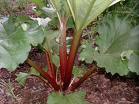 In the deserts of Israel, there is a plant that waters itself. The pant, a type of rhubarb, has specially designed leaves that channel rain water to its roots.
In the deserts of Israel, there is a plant that waters itself. The pant, a type of rhubarb, has specially designed leaves that channel rain water to its roots.
It is only known plant in the world able to self-irrigate.
The adaptation allows the rhubarb to flourish in extreme arid conditions by collecting up to 16 times more water than other plants in the region, say the scientists who published details of the discovery in Naturwissenschaften.
Simcha, Lev-Yadun, Gadi Katzir and Gidi Ne’eman of the University of Hafia, Israel first noticed the desert rhubarb when studying plants in the country’s mountainous desert.
A rare but popular plant with nature lovers and ecologists, the researchers became curious about the possible advantages of the rhubarb’s exceptionally large rosette leaves, which markedly differ from the small leaves of most desert plants.
“We know of no similar plant in other deserts of the worl,†said Botanist Simch Lev-Yadun. The morphology of the leaves looks similar to the mountainous region in which they grow, which drains water off the slopes and into the valleys.
“That ignited our imagination,†says Professor Simcha Lev-Yadun. Their study of desert rhubarb (Rheum palaestinum) growing in the Negev Desert showed that each plant typically harvests 4.2 litres of water each year, while the largest plant found harvested 43.8 litres.
Deep depressions in the rhubarb’s leaves channel water along the leaves veins, which are orientated towards it base. The leaves are also coated in a waxy cuticle, which repels water helping it flow over the leaves.
Rain is so scarce in the area that an average of just 7mm falls each year. Yet even under the slightest rain, water flows down the rhubarbs’ leaves to the main root. Further tests show this water then penetrates the soil to a depth of 10cm, helping to irrigate the plant. That’s 10times deeper than rain landing on the desert soil.
“On average, the plant’s leaves allow it to collect 16times more water than other desert plants in the region,†says Professor Lev-Yadun. That means it gathers a similar amount of water as plants living in Mediterranean climates, the researchers report.
